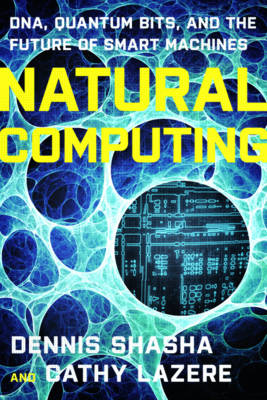
Natural Computing
DNA, Quantum Bits, and the Future of Smart Machines
Seiten
2010
WW Norton & Co (Verlag)
978-0-393-33683-2 (ISBN)
WW Norton & Co (Verlag)
978-0-393-33683-2 (ISBN)
Reports from the cutting edge, where physics and biology are changing the fundamental assumptions of computing.
Computers built from DNA, bacteria, or foam. Robots that fix themselves on Mars. Bridges that report when they are aging. This is the bizarre and fascinating world of Natural Computing. Computer scientist and Scientific American’s “Puzzling Adventures” columnist Dennis Shasha here teams up with journalist Cathy Lazere to explore the outer reaches of computing. Drawing on interviews with fifteen leading scientists, the authors present an unexpected vision: the future of computing is a synthesis with nature. That vision will change not only computer science but also fields as disparate as finance, engineering, and medicine. Space engineers are at work designing machines that adapt to extreme weather and radiation. “Wetware” processing built on DNA or bacterial cells races closer to reality. One scientist’s “extended analog computer” measures answers instead of calculating them using ones and zeros. In lively, readable prose, Shasha and Lazere take readers on a tour of the future of smart machines.
Computers built from DNA, bacteria, or foam. Robots that fix themselves on Mars. Bridges that report when they are aging. This is the bizarre and fascinating world of Natural Computing. Computer scientist and Scientific American’s “Puzzling Adventures” columnist Dennis Shasha here teams up with journalist Cathy Lazere to explore the outer reaches of computing. Drawing on interviews with fifteen leading scientists, the authors present an unexpected vision: the future of computing is a synthesis with nature. That vision will change not only computer science but also fields as disparate as finance, engineering, and medicine. Space engineers are at work designing machines that adapt to extreme weather and radiation. “Wetware” processing built on DNA or bacterial cells races closer to reality. One scientist’s “extended analog computer” measures answers instead of calculating them using ones and zeros. In lively, readable prose, Shasha and Lazere take readers on a tour of the future of smart machines.
Dennis E. Shasha, professor of computer science at the Courant Institute of Mathematical Sciences at New York University, has written the "Puzzling Adventures" column in Scientific American. He lives in New York City. Cathy Lazere, a former editor at the Economist Intelligence Unit, is a freelance writer. She is based in New York.
| Erscheint lt. Verlag | 2.7.2010 |
|---|---|
| Zusatzinfo | 50 illustrations |
| Verlagsort | New York |
| Sprache | englisch |
| Maße | 140 x 208 mm |
| Gewicht | 243 g |
| Themenwelt | Informatik ► Theorie / Studium ► Künstliche Intelligenz / Robotik |
| Naturwissenschaften ► Physik / Astronomie ► Quantenphysik | |
| Technik ► Umwelttechnik / Biotechnologie | |
| ISBN-10 | 0-393-33683-2 / 0393336832 |
| ISBN-13 | 978-0-393-33683-2 / 9780393336832 |
| Zustand | Neuware |
| Haben Sie eine Frage zum Produkt? |
Mehr entdecken
aus dem Bereich
aus dem Bereich
Buch | Softcover (2024)
REDLINE (Verlag)
CHF 27,95
Eine kurze Geschichte der Informationsnetzwerke von der Steinzeit bis …
Buch | Hardcover (2024)
Penguin (Verlag)
CHF 39,20


